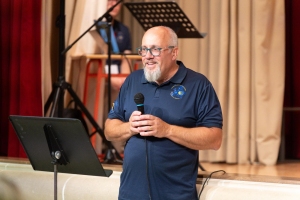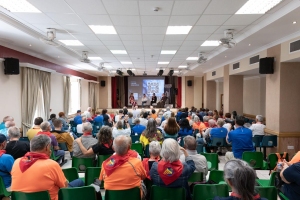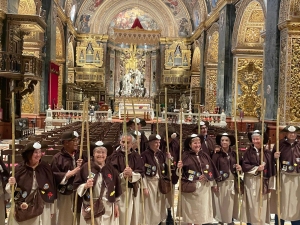On a hillside campus just outside the old town of Rabat, the Camino came into focus not as a single path, but as a network of voices. Representatives from more than twenty Camino associations across Europe gathered at St Paul’s Missionary College for the annual general assembly of Camino Europa Compostela (CEC), hosted this year by the Maltese organization XirCammini. The theme of the gathering—“It’s in the journey”—set the tone for a full day of discussion, exchange, and shared experience.
Though Malta lies far from the better-known trails of northern Spain, its role in the wider pilgrimage landscape is growing. For the dozens of pilgrims, scholars, and heritage advocates attending, the meeting offered a space to reflect not only on routes and infrastructure, but also on what pilgrimage means in an increasingly connected, and complicated, world.

Reframing Faith Tourism
The day opened with remarks from Carlo Micallef, CEO of the Malta Tourism Authority. He outlined Malta’s national strategy for faith-based travel, presenting it not as a niche market, but as a dynamic way to engage with the island’s layered history. “Malta is a living spiritual fabric,” he said, pointing to efforts to support heritage sites, events, and cross-border cooperation.
James Portelli, president of XirCammini, welcomed participants with a reminder that walking pilgrimages aren’t just about destinations. “It’s a way of seeing,” he said, “of rediscovering landscapes and stories that are already there.”
Pilgrimage as Human Continuity
The morning’s keynote lecture came from historian Dr. Dane Munro, who presented pilgrimage as a long-standing human response to transition and meaning-making. In a talk titled “Pilgrimages Transcending Time: A Millennial Perspective,” Munro traced the origins of walking pilgrimages back to the Upper Palaeolithic. He proposed a framework for understanding them as either “site-based” or “route-based”—both forms that persist in modern Europe, often overlapping.
His approach grounded the Camino in something older and broader than any single religious or cultural tradition. “Pilgrimage meets core human needs,” he argued, “whether that’s healing, transformation, or simply a space to reflect.”

Stories from the Road
One of the most resonant moments of the day came from Irish pilgrim Breandann Ó Scannail, who walked from the west coast of Ireland to Santiago de Compostela over six months – without GPS, maps, or fixed accommodation. “I walked toward the sun and trusted people along the way,” he said.
The journey was slow, unpredictable, and deeply human. “The Camino,” he told the room, “is where you discover who you are by walking through places you don’t know.”
His story served as a reminder that the Camino experience is shaped not by what one believes, but by how one moves through the world—and how the world responds.
Networks and Conservation
Throughout the day, other voices brought the focus back to structure, collaboration, and conservation. The Pilgrimaps team introduced their ongoing work to document global pilgrimage routes and encourage stronger ties between local associations. Their project blends digital mapping with oral history and aims to build bridges between institutions that often operate in isolation.
Local heritage was also in focus. Dr. Stanley Farrugia Randon of Din l-Art Ħelwa presented the restoration of San Mikiel ta’ San Ċir, a rural chapel with Arab-Byzantine influences. Long neglected, the site will be preserved as part of Malta’s own contribution to Europe’s pilgrimage heritage.
Perspectives on Meaning
A roundtable discussion in the afternoon, moderated by Sue Sergeant of the UK’s Confraternity of Saint James, explored how the Camino is interpreted today—as a religious act, a spiritual journey, or a humanist exercise. What emerged was consensus on flexibility: the Camino’s meaning isn’t fixed. It adapts. “It’s not about what you believe,” one panelist said. “It’s about what you’re ready to encounter.”
That openness has become a hallmark of the modern Camino, where walkers of different backgrounds often share the same road, if not the same reasons.

Building a Shared Future
Short presentations from Camino associations across Europe followed, highlighting work happening in places as diverse as Romania, the Netherlands, Andalusia, and Finland. Many focused on practical issues: signage, hospitality, education, trail continuity. Together, the network now recognizes 286 official Camino routes across 28 countries—covering over 83,000 kilometers.
But the shared momentum goes beyond numbers. Camino Europa Compostela, formalized in 2023, is part of a long-term effort to coordinate across borders, promote historical knowledge, and protect the routes themselves.
A Closing Symbol
The day ended in Valletta’s St John’s Co-Cathedral with an ecumenical service under the theme “Pilgrims of Hope.” Camino shells from Santiago were brought forward, blessed, and offered as a symbol of unity. Reflections were shared by pilgrims, including influencer Johnnie Walker Santiago and local voices, while a message from the Bishop of Compostela reaffirmed the Camino’s enduring role in Europe’s cultural life.
The tone was inclusive and forward-looking—a fitting close to a gathering that, at its core, wasn’t just about where people have walked, but how they’re choosing to walk together.





